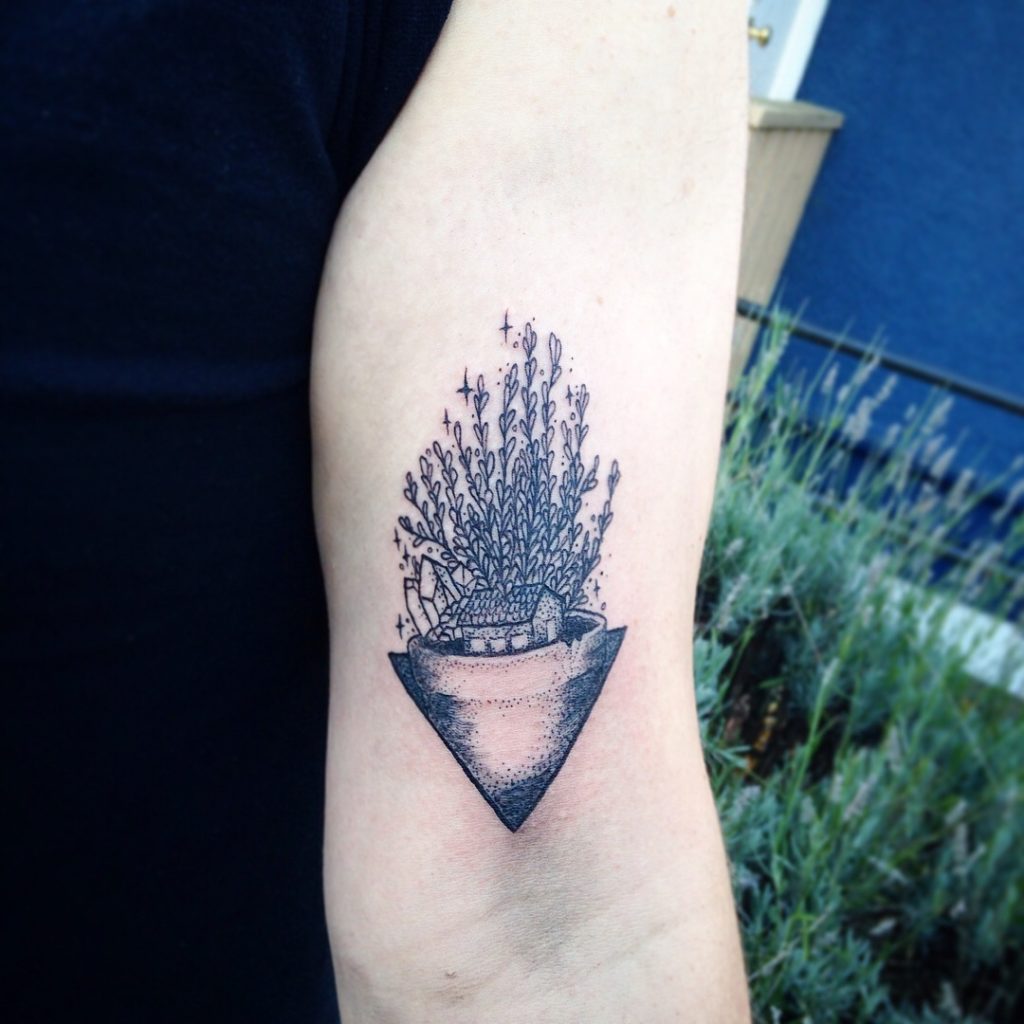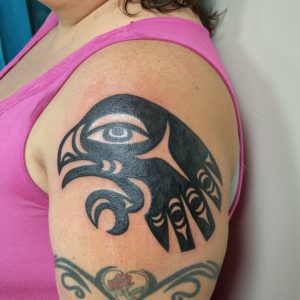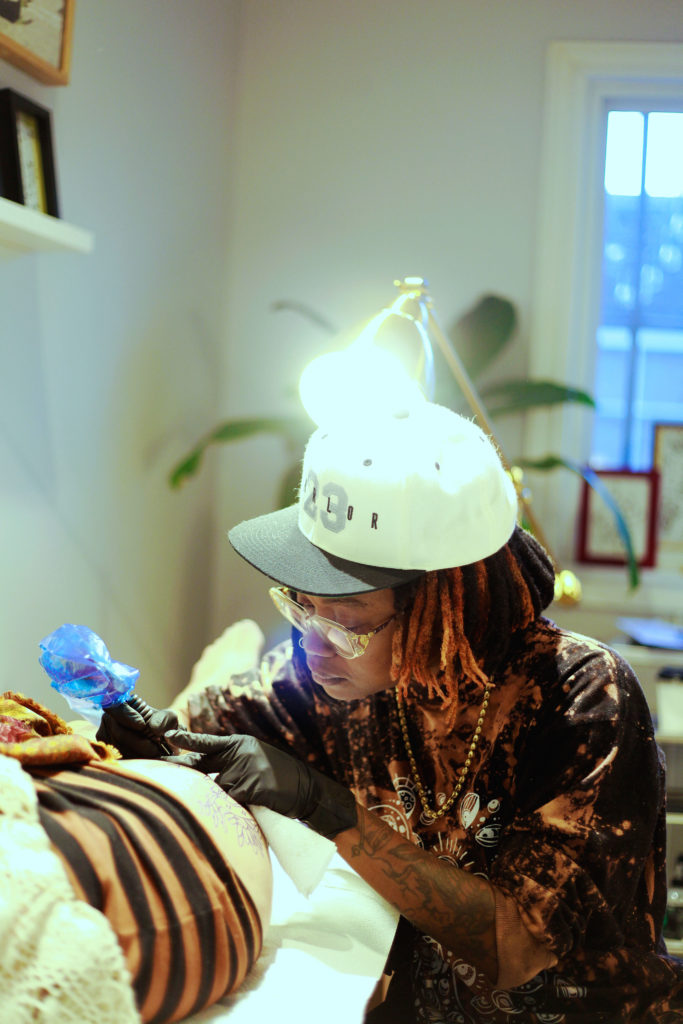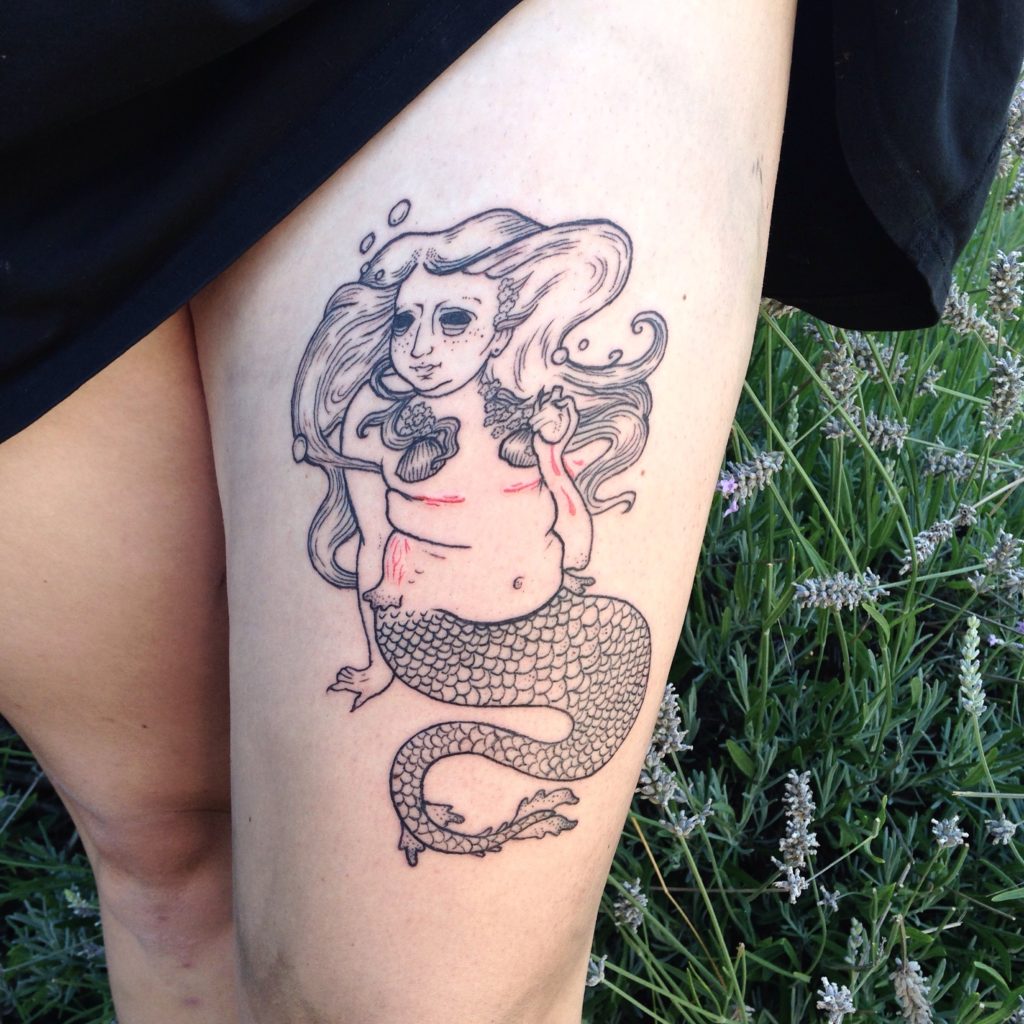STICK AND POKE. #QTTR. FLASH.
If any of these phrases mean something to you, you may have already noticed: tattooing is having a special kind of moment in the DIY scene. Sure, sporting ink on your body has always signified a rejection of mainstream mores, and might have marked you as a member of one community or another over the years. But there’s been an undeniable upsurge in illustrators, zinesters, queer artists, and justice-minded creators turning to tattooing as a means not only of self-expression, but also of community building. With tattooing practice often being guarded away as the property or knowledge of tattoo shops alone, independent tattoo artists from around the world are taking the craft back by teaching themselves and each other how to do it properly.
“I never pursued an apprenticeship [in a shop]. I never had an interest in that or interest in shop culture,” reflects Bug Cru, an illustrator tattoo artist based in Vancouver, BC. “A lot of people feel really protective of the industry, and will gatekeep information about how to do safe tattoos.”
Bug offers tattoos out of their bedroom in a punk house, and they’ve invested a lot of time and money in learning to tattoo safely and competently (I know this because I received a tattoo from them there in November, pictured on the following page). Bug started tattooing as a teenager, and taught themself about technique as well as the science of safe tattooing through books, YouTube, and conversations with like-minded DIY tattoo artists.

“I kind of fell into DIY tattooing out of circumstance. I’m just a poor kid learning to tattoo on my own, but it feels like a nice thing, and it lines up with my values,” they explained. “I want people to have access to information, and I want people to be safe. I don’t think that gatekeeping makes sense.”
Tee Fergus is a Toronto-based illustrator and tattoo artist who started her own independent tattoo practice after working in shops for three years. She echoes Bug’s concerns about the way some aspects of shop culture can hinder safety.
“There’s this certain protectiveness or entitlement about the things you can and cannot do if you don’t work at a shop, or if you learn to do it yourself,” said Tee. “It was always important for me to create the space that I felt was lacking or that was needed for people to feel safe … In the shops that I worked at it, was just like super-fast and I didn’t really get to connect with the people I was tattooing.”
As anyone who has ever gotten a tattoo can attest, giving someone your skin to permanently mark through thousands of tiny punctures can be, to say the least, vulnerable. This is why finding a tattoo artist who you can trust, and who can make you feel cared for, is crucial.
“Especially in queer world, people want to be safe around each other and feel comfortable, like, ‘Oh, it’s not some dude in a shop who’s not going to respect my boundaries or space or budget,’” says Bug, who centres consent in their tattoo practice and in their day-to-day life. For Cassandra Thompson, pictured on the cover of Broken Pencil Magazine tattoo from by Tee, being safe and cared for during a tattoo session includes taking her identity and spiritual energy into account.

“There was no way I was going to let anybody touch my skin who wasn’t a person of colour or who didn’t identify as a woman or queer or trans,” says Cassandra.
“I have conversations with tattoo artist because it is a healing [act]. I’m talking about the microaggressions I experience on the street as a person of colour and as a woman, as someone queer, as someone Black. I’ve always been able to do that with Tee.”
Negative assumptions about how ink will take to darker skin are common, and just one of many reasons people of colour might steer clear of tattoo shops dominated by white folks. Tee’s tattoo process and designs are directly founded on a desire to create safe and positive spaces for other people of colour in the tattoo scene.
“I never really saw anybody like myself that I could relate to in that world, so I thought it would be cool to have that representation. So that someone else that’s looking for someone that looks like them, or maybe looks like me, can see themselves,” reflects Tee. “I often say that tattooing chose me, it’s part of my duty.”

This cosmic path towards to tattooing as a political and cultural practice resonates with Dion Kaszas as well. Kaszas is a Hungarian, Métis, and Nlaka’pamux tattoo artist and cultural tattoo practitioner based in Salmon Arm, B.C. Kaszas works out of a shop, but through his scholarly research and personal practice has found himself centering tradition and identity in his
tattoo practice.
“As I began to become aware of the way that the revival of tattooing among Indigenous peoples in California, New Zealand, the Philippines, and Samoa was working to uplift and strengthen these people, and as I became more competent as a tattooer, I sensed that the revival of my ancestral tradition was one of the responsibilities that the Creator had given me,” says Kaszas. He uses the hand poke and skin stitch tattooing techniques traditionally used by his ancestors and by other cultural practitioners today.
The interpersonal and collective meaning of these methods and designs adds a complexity to their practice.
“Sometimes people come to me wanting to confirm who they know themselves to be on the inside, because they are secure in their place in their respective Indigenous communities. Then, on the other hand, some folks come to me knowing that they need their ancestral mark and having that mark starts them on a journey to find out how to live more in line with the reality of who they are as an Indigenous person,” he explains. “I personally operate so that I am only tattooing designs on people who have a right to wear them.”
Tee also brings culture and purpose into her designs, which frequently feature archetypal imagery like plants and moons, as well as contemporary cultural references like Cardi B and sneakers. She often incorporates eyes into her work as a symbol of visibility, of protection, and of a community looking out for each other. Bug brings in an affinity for magical and spiritual imagery as well — plants, candles, sometimes bizarre creatures populate their artwork and “flash” offerings, set price designs typically advertised on Instagram or kept in a portfolio.

While many DIY and community-based tattoo practitioners are self-taught or working outside of institutions, a growing community online and in-person has allowed for the development of practices like flash. Importantly, it has also created new avenues for knowledge sharing outside of the more competitive or gatekeeping tendencies. Like most people, Bug and Tee express conflicted feelings about the work and the performance of social media. But for both, it has allowed them to connect with other tattooers and set up room exchanges or residencies, share tips, and hone in on a personal style.

For Kaszas, sharing his tattooing knowledge with other Indigenous artists is crucially important. For this reason, he and his friends Jordan Bennett and Amy Malbeuf co-founded the Earthline Tattoo Residency, which trains four to six Indigenous artists in hand poke and skin stitch technique every year, with an emphasis on safe tattooing principles.
“The most fundamental traditional teaching is the teaching that asks us to do no harm and to build up our families and communities,” explains Kaszas. “With this in mind, if our tattooing practices have the potential to do harm, then we are no longer acting in a traditional, culturally sensitive way.”
Whether you’re inked head to toe or it’s your first time under the needle, you can feel it on your skin: a new wave is coursing through the tattooing community, centering community, wellbeing, and political action.
Photography by: Jah Grey
